As the COVID-19 pandemic starts to level off in 2022s, LitePoint hosts the Innovation and Testing Technology Forum in Taipei and Hsinchu city on August 2 and 4 respectively. This annual event is targeted to share the latest trends in wireless technologies including 5G frequency range expansion, 5G O-RAN white-box solution, the early specification for super-fast Wi-Fi 7 and the latest ultra-wideband (UWB) use case applications. LitePoint provides a complete wireless test solution that enable customers to test wireless devices with optimized test time reduce to capture the latest market trends and opportunities.
Elvin Ren, LitePoint's General Manager of Sales in Taiwan, India and South East Asia, gave his welcoming speech to kick-off the forum this year. Driven by 5G and Wi-Fi technologies, Taiwan networking OEM/ODM vendors have a strong growth potential and can benefit from the upcoming location awareness applications with Internet of Things (IoT). LitePoint sees a positive trajectory in business opportunity in wit UWB with many new customers approaching LitePoint for UWB test solutions. To meet the testing challenges and expand business opportunities, LitePoint's strategy help the electronics supply chain accomplish rapid volume manufacturing through optimized test equipment and turnkey test automation.
Simplicity Through Innovation to lead test automation development
The keynote speech of Dr. Rex Chen, LitePoint's Director of Strategic Business Development for 5G, share insights on the latest trends in 5G mobile, CPE and O-RAN development as well as the challenges ahead in the 5G deployment journey. As global mobile data traffic doubles roughly every three years, the exponential data consumption drives the demand to open up more frequency bands and 5G infrastructure deployments. This has created new opportunity for various wireless products, especially the rapid growth of 5G CPE devices in FWA (Fixed Wireless Access) applications in North America as many households are upgrading their residential broadband Internet access.
5G FWA CPE devices integrate both 5G and Wi-Fi technologies into a single device and accelerates the broadband coverage in rural and suburban areas. On the other hand, 5G Small Cells solves the "Density Problem" and small cells play an important role to solve the "5G Infrastructure Problem". Essentially, small cells are enablers for better network coverage, address the high data rate concern, and boosts the business in O-RAN solutions.
His presentation also cover several mainstream wireless technologies including the latest development of Wi-Fi technology with Wi-Fi 7 getting the most attention and will debut on the market in 2024 or 2025 for volume production. Another highlight is UWB device shipment growth is expecting a 35% CAGR through 2025. The driving force is the huge adaptation of automotive, mobile payment and IoT applications.
Leveraging the product strategy of "Simplicity Through Innovation", LitePoint simplifies wireless testing with a single-box test solution that is easy to use and high optimized for production floor. This approach is expanding the millimeter wave (mmWave) frequency bands, supporting accomplish effective mass production through multi-DUT (Devices Under Test), OTA (Over the Air) testing, and production line testing with automated test equipment. LitePoint is monitors the advancement of different wireless technologies closely to move quickly develop a more cost-effective test solutions that customers can benefit from as well.
Latest developments of Wi-Fi 7 and testing solutions
Young Huang, Deputy Manager of LitePoint Application Engineering Department, continue the discussion with Wi-Fi 7. The released Draft 2.0 specification has attractive features with data speed reaching 46 Gbps which is 4.8 times of Wi-Fi 6. New features such as MLO (Multi-Link Operation, will be able to transmit and receive on both the 5 GHz and 6 GHz multiple frequency bands simultaneously and enhance the throughput of a single data session and avoid unpredictable channel blocking or frequency interference. With standard specification of maximum bandwidth at 320MHz and modulation of at 4096 QAM and up to 16×16 MIMO, the technology supports new emerging applications that require very high rate rates such as multiple-user AR/VR, cloud gaming, and 8K media streaming applications.
Talking about important testing cases in this session, Huang highlighted technologies such as EHT packet formats, IEEE channel distribution and Wi-Fi 7 data transmission speed. With a denser constellation, test equipment requires higher transmitter accuracy to measure Error Vector Magnitude (EVM)and raise the testing barriers in Wi-Fi 7.
With global Wi-Fi 7 chipsets expecting to sample chips in 2023, LitePoint test solution offering ranges from IQxel series models including IQxel-M4W 6G for testing Wi-Fi 6 devices, IQxel-MW 6G, IQxel-MW 7G for testing 160MHz bandwidth feature, and IQxel-MX for testing 320MHz bandwidth requirements. For production, the IQxel-M8X and IQxel-M16X models are will be suitable for volume production.
Recent trends and advances in UWB positioning
Chris Chao, Engineering Manager of LitePoint Application Engineering Department, share insights on Micro-Positioning by connecting the rapid growth of the UWB market. The success of UWB can largely be attributed to the popularity of 3D positioning, indoor precise positioning, smart home applications and automotive use cases. In China, UWB has emerged as a promising navigation technology with a rapid market growth and his talk address the three major product trends in UWB, Bluetooth and Wi-Fi 802.11az.
Further, Chao introduce four major distance measuring technologies including Received Signal Strength Indication (RSSI), Time of Flight (ToF), Angle of Arrival (AoA) and Channel Sounding/ Phase. UWB chips are integrated with mainstream devices like smartphone, wearable and other mobile devices to provides accurate 3D positioning within 5 to 10 cm accuracy with lower power consumption, high security and high interference resistance functions.
The Wi-Fi 802.11az specification, or called Next Generation Positioning (NGP), is highly regarding as next generation positioning technology for indoor use case. The core distance detection scheme is based on ToF. Major Wi-Fi chip makers are preparing to launch new products based on market needs. Another unique feature of 802.11az enabling multiple device positioning identification through one UPLINK signaling sequence in OFDMA and this feature has triggered a surge of versatile new applications in the market.
LitePoint provides comprehensive testing solution to test the devices with various mixed positioning technologies. The IQxel-MW 7G and IQxel-MX are targeted for Wi-Fi and BT's high accuracy distance measurement. LitePoint's IQgig-UWB tester is used to fulfill the Conformance Test following FiRa Certification. and for UWB device characterization and design verification in R&D. LitePoint is a market leader and dominant player for UWB test solutions.
IQ3107 RF-Port Switch and APLC 2.0 solving more 5G bands and cable loss
Frank Hung, LitePoint Senior Engineer, share test solutions that extend beyond 5GHz frequency bands. The 3GPP R17 standard has released new frequency bands including FR1 spectrum band n96 ranging from 5.925 to 7.125 GHz with 1200 MHz bandwidth. 5G FR2 band n263 will extend to 57 to 71 GHz and reserve another 14GHz bandwidth to support new metaverse applications.
Overall, the frequency bands for 5G New Radio (5G NR) extends from 400MHz to 70GHz. LitePoint test solution address the entire spectrum covering these 5G frequency ranges with the IQxstream-5G, IQgig-IF and IQgig-5G among its product portfolio.
Wider frequency bands combined with more antennas design for user devices have result in new technical challenges for 5G device testing. For example, in production lines more antennas will require test equipment with adequate RF ports. At the same time, it will increase the path loss affecting the measurement accuracy and consume more setup time. To solve these problems, LitePoint's IQ3107 RF-Port switch for RF test port expansion from from 4 to 16. The IQ3107 also enable Multi-DUT device testing to for improve volume test efficiency. To deal with path loss problems in production setup, LitePoint uses Auto Path Loss Calibration(APLC) software to lower setup cost and high precision automatic calibration capabilities.
One Box testing solutions for Small Cell and O-RAN RU device Tests
The last speaker was Vito Liao, Deputy Manager of LitePoint Application Engineering Department. His presentation address the topics of CPE, Small Cell and O-RAN Radio Unit device testing solution.
Liao introduce the important test items and use cases for small cell and O-RAN testing per 3GPP 38.141 specification. These testing scenarios cover both Tx and Rx such as Total Power Dynamic Range(TPDR), Time Alignment Error(TAE), Cumulated Adjacent Channel Leakage Ratio(CACLR) and Operation Band Unwanted Emission(OBUE) among others.
LitePoint's IQxstream-5G+ is a one box tester solution to address these market segments and test requirements such as 1024 QAM modulation and 2x2 MIMO testing. Because the complete setup procedures for each test item is complex to setup and install, LitePoint provides IQfact5G Shop Floor software tool to make the entire procedures easier to manage including calibration and parameter setting. Furthermore, LitePoint's IQmi software tool is designed to support customers to implement customized auto-testing procedures or process flows.
The Evolving Roles of Small Cells in Wireless Infrastructure
The last session for the day was an industry panel to discuss the opportunities and challenges of 5G deployment and in particular with Small Cell and O-RAN. Eric Huang, DIGITIMES Vice President moderated this panel among with panelist guests that include Jacky Chou from Qualcomm, Dr. Rex Chen from LitePoint, Selena Hsu, from Auray Technology and Tsaiyu Huang from Alpha Networks. The panel discussed about the industry trends in O-RAN and the requirements for successful roll-out that is scalable and cost effective.
The panelists share insights about the role the Taiwan OEM and supply chain can play a role in the overall O-RAN ecosystem. First, system integration is critical to support multi-vendor model across the value chain from both the hardware site as well as software component.. Further, the shift to open software and server-based platforms make O-RAN deployment very cost effective but it also raises quality checks and cybersecurity risk assessment that need to address the critical issue.
One way that Taiwan can become a major value chain provider in 5G O-RAN is by establishing local test laboratory and certification capability for the industry. This test service provider can help OEM's and ecosystem partners to verify the compatibility and system performance before launching on a major global telecom network provider. And at the same time, these testing help solution providers to identify and fix issues early on and enable a smoother working relationship with the right partners to penetrate the target global markets.
Meanwhile, participating in O-RAN PlugFest events offered by regional telecom operators and players is another way to accelerate development of O-RAN technologies. From LitePoint product offering, a simplified and highly reliable single box test solution simplifies the test challenges for customers in launching their 5G O-RAN and small cell products out in the market.

Elvin Ren, LitePoint's General Manager of Sales in Taiwan
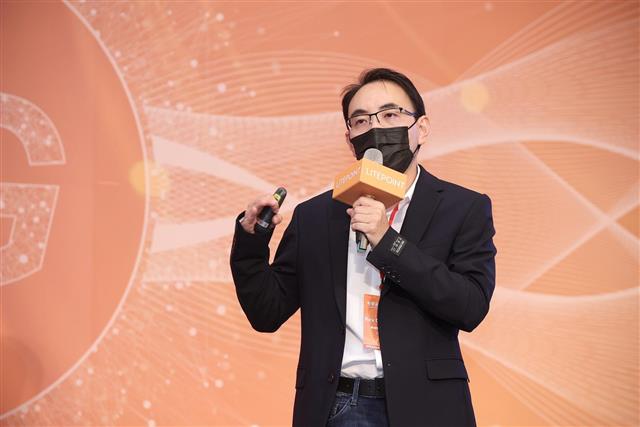
Dr. Rex Chen, LitePoint's Director of Strategic Business Development for 5G
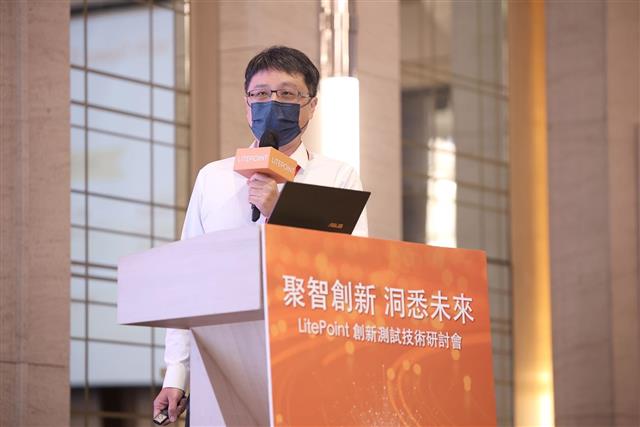
Young Huang, Deputy Manager of LitePoint Application Engineering Department
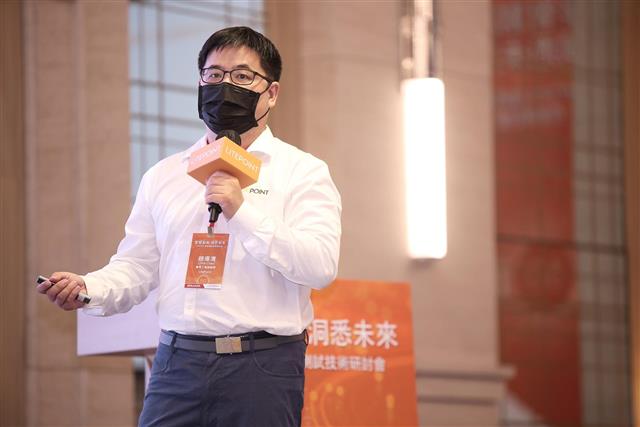
Chris Chao, Engineering Manager of LitePoint Application Engineering Department
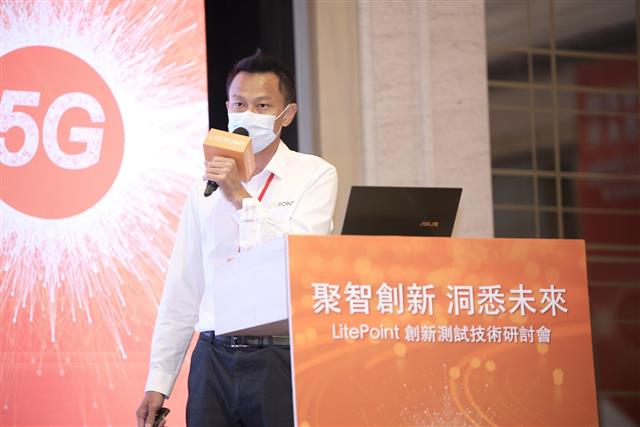
Frank Hung, LitePoint Senior Engineer
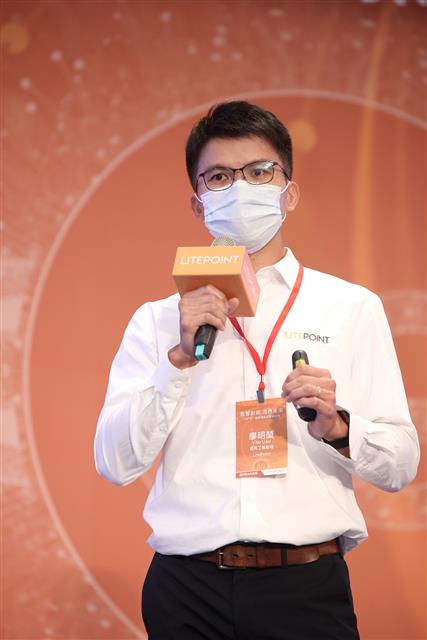
Vito Liao, Deputy Manager of LitePoint Application Engineering Department
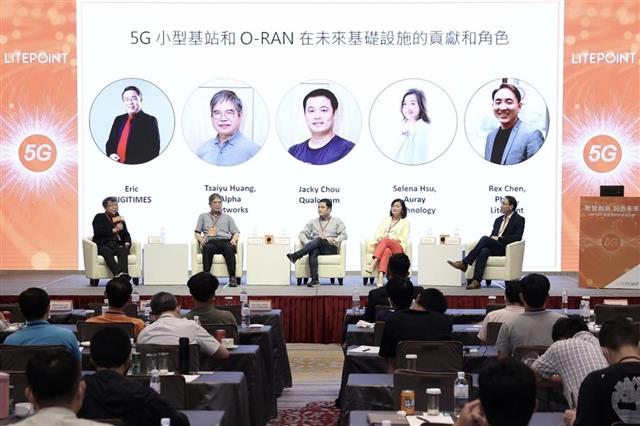
Panel discussion: Eric Huang, DIGITIMES; Tsaiyu Huang, Alpha Networks; Selena Hsu, Auray Technology; Rex Chen, Ph.D., LitePoint (from left to right)